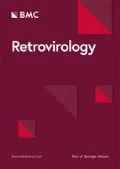The diagnosis of Human T cell Lymphotropic Virus type 1 (HTLV-1) infection is based on serology and PCR. The burden of HTLV-1 viral infection is monitored by measuring the proviral load [PVL] in peripheral blood. This assay is not useful for isolation of HTLV-1-infected cells. HTLV-1 Tax upregulates CD25 expression on infected CD4+ T cells. However, CD4+CD25+ is also the phenotype of activated T cells. CCR4 is a chemokine receptor expressed on subsets of activated T cells. HTLV-1-infected cells secrete the CCR4 ligand CCL22, and preferentially infect CCR4+ Cells. We studied the expression of CD25 and CCR4 in lymphocytes and its relation to PVL. We performed 11-colour immunophenotyping and HTLV-1 PVL quantification on 53 samples obtained from 36 HTLV-1 infected patients, [10 asymptomatic carriers (AC); 11 patients with HTLV-1-associated myelopathy (HAM); 4 co-infected with HIV; 11 with chronic/smouldering adult T-cell leukaemia/lymphoma (ATL)] and 3 uninfected individuals. Increased frequency of CD25+CCR4+ T cells [median: 14.7%, range: 1.95-91.3%] was observed in all HTLV-1 infected patients; the frequency correlated with PVL [Spearman r=0.89, P <0.001, Linear R2 = 0.61]. CD4+ and CD8+ cells from 12 patients [6ACs and 6 HAMs] were separated for PVL estimation. CD25+ CCR4+ cell counts correlated closely with PVL in CD4+ cells [Spearman r=0.816, P <0.001, linear R2=0.886] but not in CD8+ cells. Frequency of CD25+CCR4+ T cells correlated with PVL change in treated ATL patients. We conclude that CD25+CCR4+ cells can be used as a specific marker for monitoring of HTLV-1 infection and isolation of HTLV-1 infected cells.
Author information
Authors and Affiliations
Corresponding author
Rights and permissions
This article is published under an open access license. Please check the 'Copyright Information' section either on this page or in the PDF for details of this license and what re-use is permitted. If your intended use exceeds what is permitted by the license or if you are unable to locate the licence and re-use information, please contact the Rights and Permissions team.
About this article
Cite this article
Kagdi, H., Melamed, A., Hilburn, S. et al. CD25+CCR4+ cells as a marker of HTLV-1-infected cells in peripheral blood. Retrovirology 11 (Suppl 1), P139 (2014). https://doi.org/10.1186/1742-4690-11-S1-P139
Published:
DOI: https://doi.org/10.1186/1742-4690-11-S1-P139

